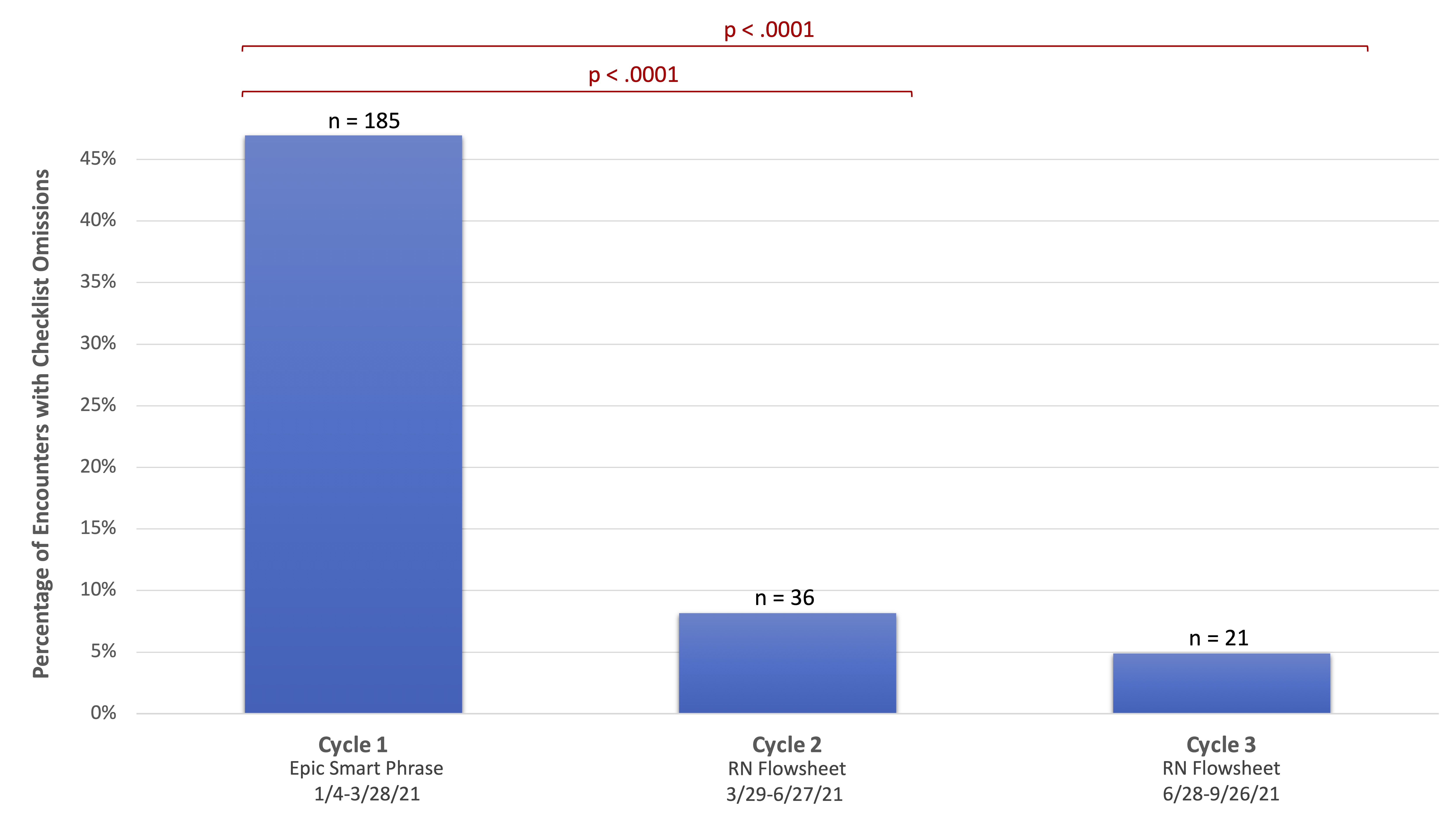Hospital Medicine: Hospital Medicine Quality Improvement
Category: Abstract Submission
Hospital Medicine: QI
324 - A family centered rounds checklist integrated into the electronic healthcare record is feasible, efficient, and accurate within a community hospital setting
Sunday, April 24, 2022
3:30 PM - 6:00 PM US MT
Poster Number: 324
Publication Number: 324.323
Publication Number: 324.323
Mason A. Shaner, University of Michigan Medical School, Santa Monica, CA, United States; Lyn M. Dos Santos, Stanford University School of Medicine, Walnut Creek, CA, United States; Tristan C. Nichols, Stanford Childrens Health, Oakland, CA, United States; Gayatri B. Madduri, Stanford University School of Medicine, Walnut Creek, CA, United States

Mason A. Shaner, BS
Medical Student
University of Michigan Medical School
Santa Monica, California, United States
Presenting Author(s)
Background: Family Centered Rounds (FCR) is the gold standard of communication between healthcare providers and families of hospitalized children. Few tools capture the universal aspects of successful FCR directly within the electronic health record (EHR). A search of the Epic Community Library identified 4 flowsheets and 1 note template for FCR documentation that were institution-specific and limited in scope.
Objective: To quantify and standardize FCR conducted on our pediatric floor, we created and assessed the feasibility, efficiency, and accuracy of a nurse-led FCR checklist implemented through Epic for rounding encounters during the 2021 calendar year.
Design/Methods: Within our community hospital's 16-bed acute care pediatric floor, we involved 8 RNs. Before our intervention, RNs documented FCR with a rounding note template which provided our baseline data through manual chart review 1-3/2020. FCR halted during the pandemic 4-12/2020. We modified a previously published validated FCR checklist by University of Wisconsin-Madison, adding interpreter use, presenter, and duration. We introduced the checklist to medical staff one month before implementation. During Cycle 1 (1/4-4/4/21), nurses used an Epic smart phrase to access the checklist. During Cycles 2-3 (4/5-9/26/21), we converted the smart phrase into a flowsheet. We collected data weekly, assessing statistical significance through control chart and Fisher Exact Test (FET).
Results: 1) Median RN documentation rates increased from baseline (70%) to 87% during Cycle 1. During Cycle 2, this increased to 97% and was sustained over 6 months (Fig 1). 2) Fewer omissions of checklist items occurred when the checklist was converted from an Epic smart phrase to a flowsheet (FET, pConclusion(s): A nurse-led FCR flowsheet implemented in Epic is feasible, accurate, and efficient in our hospital. Cycle 4, currently underway, evaluates sustainability of this intervention and surveys nurses for flowsheet acceptability. At our institution, this intervention facilitates data extrapolation to conduct FCR analysis to compare providers and monitor interpreter-use. We continue to enhance the checklist based on elements valued at our institution. This novel tool required little training at our hospital which relied on a limited number of nurses experienced in FCR documentation. We affirm this tool could be shared through Epic to facilitate quality management of FCR through data collection at other institutions.
Mason Shaner CVMasonShanerCV.pdf
Percentage of Encounters with FCR Checklist Elements Omitted Normalized to Cycle Total Rounding Encounters Percentage of encounters with omissions were normalized to total encounters for each cycle (Cycle 1: 1/4-3/28/21; Cycle 2: 3/29-6/27/21; Cycle 3: 6/28-9/26/21). Omissions were defined as any patient note or flowsheet that was missing one or more family centered rounds (FCR) checklist elements. Prism was used to calculate Fisher Exact Test p-values. RN documentation omissions significantly decreased after RN flowsheet utilization (Cycle 2-3) when compared to RN smart phrase (Cycle 1). Complete p-values: Cycle 1 vs. Cycle 2, p < .0001; Cycle 1 vs. Cycle 2, p < 0.0001; Cycle 2 vs. Cycle 3, p = 0.056. FCR = family centered rounds.
Percentage of encounters with omissions were normalized to total encounters for each cycle (Cycle 1: 1/4-3/28/21; Cycle 2: 3/29-6/27/21; Cycle 3: 6/28-9/26/21). Omissions were defined as any patient note or flowsheet that was missing one or more family centered rounds (FCR) checklist elements. Prism was used to calculate Fisher Exact Test p-values. RN documentation omissions significantly decreased after RN flowsheet utilization (Cycle 2-3) when compared to RN smart phrase (Cycle 1). Complete p-values: Cycle 1 vs. Cycle 2, p < .0001; Cycle 1 vs. Cycle 2, p < 0.0001; Cycle 2 vs. Cycle 3, p = 0.056. FCR = family centered rounds.
Objective: To quantify and standardize FCR conducted on our pediatric floor, we created and assessed the feasibility, efficiency, and accuracy of a nurse-led FCR checklist implemented through Epic for rounding encounters during the 2021 calendar year.
Design/Methods: Within our community hospital's 16-bed acute care pediatric floor, we involved 8 RNs. Before our intervention, RNs documented FCR with a rounding note template which provided our baseline data through manual chart review 1-3/2020. FCR halted during the pandemic 4-12/2020. We modified a previously published validated FCR checklist by University of Wisconsin-Madison, adding interpreter use, presenter, and duration. We introduced the checklist to medical staff one month before implementation. During Cycle 1 (1/4-4/4/21), nurses used an Epic smart phrase to access the checklist. During Cycles 2-3 (4/5-9/26/21), we converted the smart phrase into a flowsheet. We collected data weekly, assessing statistical significance through control chart and Fisher Exact Test (FET).
Results: 1) Median RN documentation rates increased from baseline (70%) to 87% during Cycle 1. During Cycle 2, this increased to 97% and was sustained over 6 months (Fig 1). 2) Fewer omissions of checklist items occurred when the checklist was converted from an Epic smart phrase to a flowsheet (FET, pConclusion(s): A nurse-led FCR flowsheet implemented in Epic is feasible, accurate, and efficient in our hospital. Cycle 4, currently underway, evaluates sustainability of this intervention and surveys nurses for flowsheet acceptability. At our institution, this intervention facilitates data extrapolation to conduct FCR analysis to compare providers and monitor interpreter-use. We continue to enhance the checklist based on elements valued at our institution. This novel tool required little training at our hospital which relied on a limited number of nurses experienced in FCR documentation. We affirm this tool could be shared through Epic to facilitate quality management of FCR through data collection at other institutions.
Mason Shaner CVMasonShanerCV.pdf
Percentage of Encounters with FCR Checklist Elements Omitted Normalized to Cycle Total Rounding Encounters
 Percentage of encounters with omissions were normalized to total encounters for each cycle (Cycle 1: 1/4-3/28/21; Cycle 2: 3/29-6/27/21; Cycle 3: 6/28-9/26/21). Omissions were defined as any patient note or flowsheet that was missing one or more family centered rounds (FCR) checklist elements. Prism was used to calculate Fisher Exact Test p-values. RN documentation omissions significantly decreased after RN flowsheet utilization (Cycle 2-3) when compared to RN smart phrase (Cycle 1). Complete p-values: Cycle 1 vs. Cycle 2, p < .0001; Cycle 1 vs. Cycle 2, p < 0.0001; Cycle 2 vs. Cycle 3, p = 0.056. FCR = family centered rounds.
Percentage of encounters with omissions were normalized to total encounters for each cycle (Cycle 1: 1/4-3/28/21; Cycle 2: 3/29-6/27/21; Cycle 3: 6/28-9/26/21). Omissions were defined as any patient note or flowsheet that was missing one or more family centered rounds (FCR) checklist elements. Prism was used to calculate Fisher Exact Test p-values. RN documentation omissions significantly decreased after RN flowsheet utilization (Cycle 2-3) when compared to RN smart phrase (Cycle 1). Complete p-values: Cycle 1 vs. Cycle 2, p < .0001; Cycle 1 vs. Cycle 2, p < 0.0001; Cycle 2 vs. Cycle 3, p = 0.056. FCR = family centered rounds.